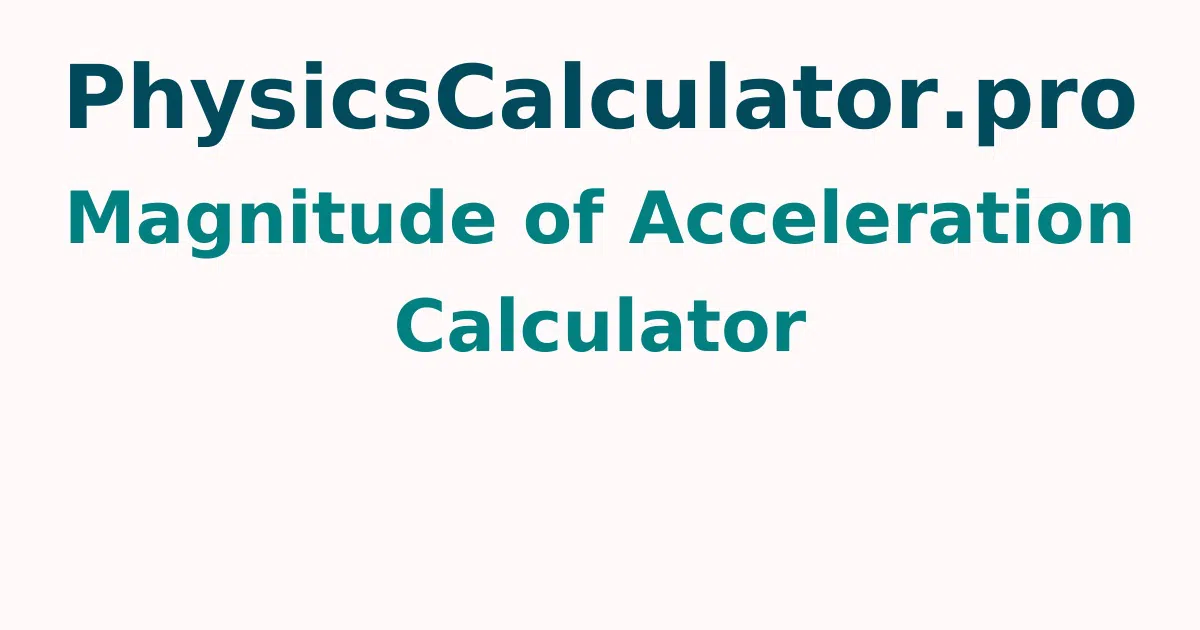Magnitude of Acceleration Calculator
Welcome to our magnitude of acceleration calculator, a fantastic tool for calculating acceleration magnitude. All you have to do is simply type in the inputs and click on the calculate button to avail acceleration magnitude in seconds. To learn more on what is meant by acceleration magnitude, how to use acceleration magnitude calculator read the article below for better understanding.
How do I Use this Acceleration Magnitude Calculator?
This magnitude of acceleration tool is really nice, and it's so good that it can really help you solve your problem and be useful. This tool is a web-based online tool that is completely free to use. It will assist you in resolving your magnitude of acceleration, which can be extremely beneficial. This tool is extremely simple to use and can be accessed from any device and from any country on the planet.
This tool was created for students to use in the event of an emergency or in any other way they see fit. It's free, and there's no limit to how much you can use it, so you can use it as much as you want. This tool also works well on a smartphone, allowing you to use it wherever you are. Even those with no prior knowledge of the subject will be able to use this tool.
The magnitude of acceleration calculator: What does it mean?
Speeding up is defined as a change in speed. m/s^2 is the SI unit for speed. Because speed is a vector in physics, the question of whether quickening is also a vector arises.
Totally! What is the best way to verify this? Let's say we have a car that accelerates at m/s^2. Is the amount of information sufficient? - So far, no. To visualise, we'll need a simplified framework and a vehicle that accelerates. Due to the fact that the quickening is a vector, we also need to know the vehicle's course and initial stage to do so. The portrayal is vastly improved if we say it accelerates north-west at 2 m/s^2 from point (0,3).
The value of 2 m/s^2 represents the speed increase in our situation. In material science, what is a vector size? We can say it's just a number when it comes to effortlessness. When all is said and done, we should be able to determine all of the vector's properties, but this is usually only enough to give the magnitude.
Consider the scenario of a free-falling article. When we say it accelerates at a rate of 9.81 m/s^2, it's difficult to visualise as a gravitational force consistently draws into the article's middle (implying downwards from our perspective).
Following this brief presentation, it's past time for us to learn how to determine the extent of quickening. To find the answer, jump to the following areas.
How do I use this Magnitude of Acceleration Calculator?
You don't have to do much to use this tool, and you don't have to be concerned about anything. Because this tool is free and web-based, all you have to do to use it is follow a few simple steps. The following are some instructions for using the magnitude of acceleration calculator.
- Step 1: As you can see, this tool has some text boxes where you will enter all of your numbers.
- Step 2: So, enter your phone number here and double-check it to ensure you get the correct answer.
- Step 3: After you've entered your equation value in the text box, all you have to do now is press the calculate button to get the magnitude of acceleration.
Get similar concepts of physics all under one roof explained clearly with step by step process on Physicscalculatorpro.com a trusted portal for all your needs.
FAQs on Magnitude of Acceleration Calculator
1. What is the most accurate method for calculating centripetal acceleration?
The centripetal acceleration ac, is equal to the square of the body's speed v along the curve divided by the distance r from the circle's centre to the moving body; ac = v2/r. The centripetal acceleration is measured in metres per second squared.
2. With mass and friction, how do you calculate acceleration?
The friction force is determined by an object's mass as well as the coefficient of sliding friction between the object and the surface it slides on.
3. What method do you use to determine the magnitude of velocity?
Multiply the constant acceleration rate by the time difference to get the magnitude of the velocity at any point in time, then add it to the initial velocity. For example, If you drop a rock off a cliff its velocity will increase by 32 feet per second every second.
4. What is the size and direction of the problem?
A vector is made up of two types of data: magnitude and direction. The magnitude of a vector tells us how long it is, while the director tells us which way it points. The direction of a vector can be expressed in a variety of ways, but it is most commonly expressed in degrees. Vectors include things like acceleration and velocity.
